Sir Harold Kroto
Biographical
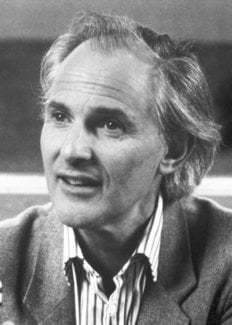
I was the kid with the funny name in my form. That is one of the earliest memories I have of school (except for being forced to finish school dinners). Other kids had typical Lancashire names such as Chadderton, Entwistle, Fairhurst, Higginbottom, Mottershead and Thistlethwaite though I must admit that there were the odd Smith, Jones and Brown. My name at that time was Krotoschiner (my father changed it to Kroto in 1955 so it is now occasionally thought, by some, to be Japanese). I felt as though I must have come from outer space – or maybe they did! I now realise that I had made a continual subconscious effort to blend as best I could into the environment by making my behaviour as identical as possible to that of the other kids. This was not easy indeed it was almost impossible with a couple of somewhat eccentric parents (in particular an extrovertly gregarious mother) who were born in Berlin and came to Britain as refugees in their late 30’s.
Bolton is a once prosperous but then (the fifties) decaying northern English town which is rightfully proud of its legendary contributions to the industrial revolution – the likes of Samuel Crompton and Richard Arkwright were Boltonians. Indeed we lived in Arkwright St. and I shall always remember walking to school each morning past the windows of cotton mills through which I could see the vast rows of massive looms and spinning frames operated by women who had been working from at least six o’clock in the morning, if not earlier.
My efforts to merge into the background meant, among other things such as fighting (literally) for survival, speaking only English (all real Englishmen expect others to speak English) – though I allowed myself to absorb just enough German to understand what my parents were saying about me when they spoke German. One specific memory was that when I did particularly poorly at French one year my Father gave me a very large French dictionary for my birthday – was I pleased!!!
My name seems to have its origins in Silesia where my father’s family originated and there is a town in Poland now called Krotoszyn (then Krotoschin). My father’s family came from Bojanowo and set up a shop in Berlin where my father was born in 1900. The original family house, which was then a shop, still exists in the main square in Bojanowo. I have an old photograph which shows the sign “I. Krotoschiner” in gothic characters emblazened over the window. I visited the town recently and, apart from cars rather than horsedrawn carts and the sign, little has changed – the Hotel Centralny is now the Restauracja Centralny and the aerials on the roofs are still there!
My father, who originally wanted to be a dress designer but somehow ended up running a small business printing faces and other images on toy balloons, had to leave Berlin in 1937 and my mother (who was not Jewish) followed a few months later. I always felt that my parents had a really raw deal, as did almost everyone born in Europe at the turn of the Century. The First World War took place while they were teenagers, then the Depression struck and Hitler came to power while they were young adults. They had to leave their home country and then the Second World War broke out and they had to leave their home again. When my father was 45 he had to find a new profession, when he was 55 he set up his business again and when he was 65 he realised I was not going to take it over. He sold the business and retired in his early 70’s.
I do not know how my father managed to catch the train to take him over the border into Holland in 1937. For as long as I knew him he was always late for everything; he invariably missed every train or bus he was supposed to catch. He told me that this was because he was called up in 1917 to go to the Front but arrived at the station just as the train was pulling out. When he asked the station master what he should do, he was told to go home. From then on he decided to make a point of missing trains and buses, but seems to have made one exception, in 1937. My parents managed to set up their small business again in London but the effort was, of course, short lived due to the outbreak of the War in September 1939. I was born in Wisbech (a very small town in Cambridgeshire to which my mother was evacuated) on Oct 7th 1939 in the first month of the War so I was a war baby. My father was interned on the Isle of Man because he was considered to be an enemy alien; my mother (who was also an alien, but presumably assumed not to be an enemy one) was moved (with me – when I was about one year old) from London to Bolton in 1940. After the war my father became an apprentice engineer and because he was so good with his hands he managed to get a job as a fully qualified toolmaker at an engineering company in months rather than years.
In 1955, with help from friends in England and Germany from before the war, he set up his own small factory again, this time to make balloons as well as print them. I spent much of my school holidays working at the factory. I was called upon to fill in everywhere, from mixing latex dyes to repairing the machinery and replacing workers on the production line. I only now realise what an outstanding training ground this had been for the development of the problem solving skills needed by a research scientist. I am also sure that what I was doing then would contravene present-day health and safety at work regulations. I would have been considered too young and inexperienced to do the sort of maintenance work that I was often called upon to do. I did the stocktaking twice-a-year using a set of old scales with sets of individual gram weights (weighing balloons 10 at-a-time to obtain their average weights), my head, log tables and a slide rule to determine total numbers of various types of balloons. No paradise of microprocessor controlled balances then. After each stocktaking session I invariably felt that I never wanted to see another balloon as long as I lived.
My parents had lost almost everything and we lived in a very poor part of Bolton. However they did everything they could to get me the best education they could. As far as they were concerned this meant getting me into Bolton School, a school with exceptional facilities and teachers. As a consequence of misguided politically motivated educational policies this school has become an independent school and it bothers me that, were I today in the same financial position as my parents had been when I was a child, I would not be able to send my children to this school. Though I did not like exams or homework anymore than other kids, I did like school and spent as much time as I could there. At first I particularly enjoyed art, geography, gymnastics and woodwork. At home I spent much of the time by myself in a large front room which was my private world. As time went by it filled up with junk and in particular I had a Meccano set with which I “played” endlessly. Meccano which was invented by Frank Hornby around 1900, is called Erector Set in the US. New toys (mainly Lego) have led to the extinction of Meccano and this has been a major disaster as far as the education of our young engineers and scientists is concerned. Lego is a technically trivial plaything and kids love it partly because it is so simple and partly because it is seductively coloured. However it is only a toy, whereas Meccano is a real engineering kit and it teaches one skill which I consider to be the most important that anyone can acquire: This is the sensitive touch needed to thread a nut on a bolt and tighten them with a screwdriver and spanner just enough that they stay locked, but not so tightly that the thread is stripped or they cannot be unscrewed. On those occasions (usually during a party at your house) when the handbasin tap is closed so tightly that you cannot turn it back on, you know the last person to use the washroom never had a Meccano set.
At no point do I ever remember taking religion very seriously or even feeling that the biblical stories were any different from fairy stories. Certainly none of it made any sense. By comparison the world in which I lived, though I might not always understand it in all aspects, always made a lot of sense. Nor did it make much sense that my friends were having a good time in a coffee bar on Saturday mornings while I was in schul singing in a language I could not understand. Once while my father and I were fasting, I remember my mother having some warm croissants – and did they smell good! I decided to have one too – ostensibly a heinous crime. I waited for a 10 ton “Monty Python” weight to fall on my head! It didn’t. Some would see this lack of retribution as proof of a merciful God (or that I was not really Jewish because my mother wasn’t), but I drew the logical (Occam’s razor) conclusion that there was “nothing” there. There are serious problems confronting society and a “humanitarian” God would not have allowed the unaccountable atrocities carried out in the name of any philosophy, religious or otherwise, to happen to anyone let alone to his/her/its chosen people. The desperate need we have for such organisations as Amnesty International has become, for me, one of the pieces of incontrovertible evidence that no divine (mystical) creator (other than the simple Laws of Nature) exists.
The illogical excuses, involving concepts such as free will(!), convoluted into confusing arguments by clerics and other self-appointed guardians of universal morality, have always seemed to me to be just so much fancy (or actually clumsy) footwork devised to explain why the fascinating and beautifully elegant world I live in operates exactly the way one would expect it to in the absence of a mystical power. Of course the excuses have been honed and polished over millennia to retain a hold over those unwilling or unable to accept that, as a Croatian friend of mine once neatly put it, “When you’ve had it you’ve had it”.
The humanitarian philosophies that have been developed (sometimes under some religious banner and invariably in the face of religious opposition) are human inventions, as the name implies – and our species deserves the credit. I am a devout atheist – nothing else makes any sense to me and I must admit to being bewildered by those, who in the face of what appears so obvious, still believe in a mystical creator. However I can see that the promise of infinite immortality is a more palatable proposition than the absolute certainty of finite mortality which those of us who are subject to free thought (as opposed to free will) have to look forward to and many may not have the strength of character to accept it.
[After all this, I have ended up a supporter of ideologies which advocate the right of the individual to speak, think and write in freedom and safety (surely the bedrock of a civilised society). I have very serious personal problems when confronted by individuals, organisations and regimes which do not accept that these freedoms are fundamental human rights. I feel one must oppose those who claim that the “good” of the community must come before that of the individual – this claim is invariably used to justify oppression by the state. Furthermore there has never been any consensus on what the “good” of the community actually consists of, whereas for individuals there is little difficulty. Thus I am a supporter of Amnesty International, a humanist and an atheist. I believe in a secular, democratic society in which women and men have total equality, and individuals can pursue their lives as they wish, free of constraints – religious or otherwise. I feel that the difficult ethical and social problems which invariably arise must be solved, as best they can, by discussion and am opposed to the crude simplistic application of dogmatic rules invented in past millennia and ascribed to a plethora of mystical creators – or the latest invention; a single creator masquerading under a plethora of pseudonyms. Organisations which seek political influence by co-ordinated effort disturb me and thus I believe religious and related pressure groups which operate in this way are acting antidemocratically and should play no part in politics. I also have problems with those who preach racist and related ideologies which seem almost indistinguishable from nationalism, patriotism and religious conviction.]
My art teacher, Mr Higginson, would give me special tuition at lunch times or after school was over. My father made me finish all my homework and I had to stay up until it was not only complete but passed his inspection – midnight if necessary. As time progressed, for reasons which I am not sure I understand, I gravitated towards chemistry, physics and maths (in that order) and these became my specialist subjects in the 6th form. I was keen on sport, and in school I concentrated on gymnastics whilst outside school I played as much tennis as I could. I patterned my backhand (and my haircut) on that of Dick Savitt and my service on that of Neil Fraser. At one time I remember wanting to be Wimbledon champion but decided that this goal was going to be a bit hard to achieve as I seemed to be having too much difficulty winning.
I started to develop an unhealthy interest in chemistry during enjoyable lessons with Dr. Wilf Jary who fascinated me most with his ability, when using a gas blowpipe to melt lead, to blow continuously without apparently stopping to breath in. I, like almost all chemists I know, was also attracted by the smells and bangs that endowed chemistry with that slight but charismatic element of danger which is now banned from the classroom. I agree with those of us who feel that the wimpish chemistry training that schools are now forced to adopt is one possible reason that chemistry is no longer attracting as many talented and adventurous youngsters as it once did. If the decline in hands-on science education is not redressed, I doubt that we shall survive the 21st century. I became ever more fascinated by chemistry – particularly organic chemistry – and was encouraged by the sixth form chemistry teacher (Harry Heaney, now Professor at Loughborough) to go to. Sheffield University because he reckoned it had, at the time, the best chemistry department in the UK (and perhaps anywhere) – a friendly interview with the amazing Tommy Stephens (compared with a most forbidding experience at Nottingham) settled it.
I was born during the war so I just escaped military service. As all the normal places at Oxbridge were already assigned for the next two years to reemerging national servicemen, I needed to achieve scholarship level to get to Cambridge. This turned out to be a bit difficult as I had been assigned a college with an examination syllabus orthogonal to the one that I had studied. Ian McKellen, the actor, who was in the same year at school, only seems to have needed to remember his lines from his part as Henry V in the school play!
The first day that I arrived in Sheffield, I walked past a building which had a nameplate saying it was the Department of Architecture and was bemused – did people do that at University? I had somehow missed this possibility because general careers advice was non-existent at that time. With hindsight I am sure that with the advice available today I would have done something like architecture which would have conflated my art and technology interests. At Sheffield I did as much as I could. Initially I lived with a family in Hillsborough, near to the Sheffield Wednesday football ground and occasionally watched them – very occasionally as I am a Bolton Wanderers supporter. I played as much tennis as I could which helped to get me a room in a hall of residence (Crewe Hall). I played for the university tennis team and we got to the UAU (Universities Athletics Union) final twice – the team would probably have been champions without me – which they were in 1964. I wanted to continue with some form of art, which was really my passion, and became art editor of “Arrows” (the student magazine which we published each term), specialising in designing the magazine’s covers and the screenprinted advertising posters. Whilst a research student I won a Sunday Times bookjacket design competition – the first important (national) prize I was to get for a very long time. Later my cover design for the departmental teaching and research brochure “Chemistry at Sussex” was featured in “Modern Publicity” (an international annual of the best in professional graphic design) – I consider this to be one of my best publications.
In the 1960s almost everybody could play the guitar well enough to play and sing two or three songs at a party so I had a go at that too and learned just enough chords (about half-a-dozen) to play some simple songs at local student folk clubs. I also decided that I should do some administration in the Students’ Union and from secretary of the tennis team I somehow ended up as President of the Athletics Council. During my last year at University (1963-64) I spent some 2-3 hours of each day attending to administration in the sports office in the Union. That year’s involvement in embryonic politics was enough to last a lifetime. I managed to do enough chemistry in between the tennis, some snooker and football, designing covers and posters for “Arrows”, painting murals as backdrops for balls and trying to play the guitar, to get a first class honours BSc degree (1958-61) and a PhD (1961-64) as well as some job offers. I also got married.
I had been keen on organic chemistry when I arrived at Sussex (at the behest of Harry Heaney I had bought Fieser and Fieser’s Organic Chemistry and read much of it while at school – it was a good read), but as the university course progressed I started to get interested in quantum mechanics and when I was introduced to spectroscopy (by Richard Dixon, who was to become Professor at Bristol) I was hooked. It was fascinating to see spectroscopic band patterns which showed that molecules could count. I had a problem as I really liked organic chemistry (I guess I really liked drawing hexagons) but in the end I decided to do a PhD in the Spectroscopy of Free Radicals produced by Flash Photolysis – with Richard Dixon. George Porter was Professor of Physical Chemistry at that time so there was a lot of flashing going on at Sheffield.
In 1964 I had several job offers but Marg(aret) and I decided that we wanted to live abroad for a while and Richard Dixon had inveigled an attractive offer of a postdoctoral position for me from Don Ramsay at the National Research Council in Ottawa. In 1964 Marg and I left Liverpool, on the Empress of Canada, for Montreal and then went on to Ottawa by train. I arrived at the famous No. 100, Sussex Drive, NRC, Ottawa, where Gerhard Herzberg (GH) had created the mecca of spectroscopy with his colleagues Alec Douglas, Cec Costain, Don Ramsay, Boris Stoicheff and others. At the time NRC was the only national research facility worldwide that was recognised as a genuine success. I suspect that this was because the legendary Steacie had left researchers to do the science they wanted; now unfortunately – as almost everywhere else – administrators decide what should be done. I remember easily making friends with all the other postdocs who congregated each morning and afternoon in the historical room 1057 – the spectroscopy tea/coffee area. The atmosphere was, in retrospect, quite exhilarating and many there, including: Reg Colin, Cec Costain, Fokke Creutzberg, Alec Douglas, Werner Goetz, Jon Hougen, Takeshi Oka and Jim Watson and their families became our lifelong close friends. As I look back I realise that Cec Costain, Jon Hougen, Takeshi Oka and Jim Watson were to exert enormous direct and indirect influence on my scientific development. I gradually learned to recognise who was good at what and what (if anything) I was good at. To paraphrase Clint Eastwood “A (scientist’s) gotta know his limitations”- and in this somewhat daunting company I learned mine. Although I knew that my level of knowledge and understanding was limited when I arrived, I was never made to feel inferior. This encouraging atmosphere was, in my opinion, the most important quality of the laboratory and permeated down directly from GH, Alec and Cec – it was a fantastic, free environment. The philosophy seemed to be to make state-of-the-art equipment available and let budding young scientists loose to do almost whatever they wanted. Present research funding policies appear to me to be opposed to this type of intellectual environment. I have severe doubts about policies (in the UK and elsewhere) which concentrate on “relevance” and fund only those with foresight when it is obvious that many (including me) haven’t got much. There are as many ways to do science as there are scientists and thus when funds are scarce good scientists have to be supported even if they do not know where their studies are leading. Though it seems obvious (at least to me) that unexpected discoveries must be intrinsically more important than predictable (applied) advances it is now more difficult than ever before to obtain support for more non-strategic research.
In 1965 after a further year of flash photolysis/spectroscopy in Don Ramsay’s laboratory, where I discovered a singlet-singlet electronic transition of the NCN radical and worked on pyridine which turned out to have a nonplanar excited state (still to be fully published!), I transferred to Cec Costain’s laboratory because I had developed a fascination for microwave spectroscopy. There I worked on the rotational spectrum of NCN3. Sometimes Takeshi Oka would be on the next spectrometer-working next to someone with such an exceptional blend of theoretical and experimental expertise did not help to alleviate the occasional sense of inadequacy. I really learned quantum mechanics (as did we all) from an intensive course that Jon Hougen gave at Carleton University. Whenever I was in difficulty theoretically (which was most of the time) Jim Watson helped me out – when he was not busy helping everyone else out. Gradually I realised that many in the field were stronger at physics than chemistry and in retrospect I subconsciously recognised that there might be a niche for me in spectroscopy research if I could exploit my relatively strong chemistry background.
In 1966, after two years at NRC, John Murrell (who had taught me quantum chemistry at Sheffield) offered me a postdoctoral position at Sussex. We were quite keen to live in the US, however, and I managed to get a postdoctoral position at Bell Labs (Murray Hill) with Yoh Han Pao (later Professor at Case Western) to carry out studies of liquid phase interactions by laser Raman spectroscopy. David Santry (now Professor at McMaster) was also working with Yoh Han at that time and each evening Dave and I carried out CNDO theoretical calculations on the electronic transitions of small molecules and radicals. I learned programming (Fortran) from Dave who threw me in at the deep end by showing me how to modify and correct the programs and then left me to see if I could do it myself.
During the year I received another letter from John Murrell to say that the position that had been available at Sussex the previous year was still available but would not be so for much longer. Thus Marg, Stephen (who had been born in Ottawa) and I came back to the UK- my annual salary dropped from $14000 to 1400 pounds, ouch! Marg had to find part-time employment as soon as possible although pregnant with our second son, David (we were poorer – but we were happier …. ! ! ! ). I was just about to start writing off for some positions back in the US and had just located the address of Buckminster Fuller’s research group (I was interested in the way that predesigned urban sub-structures might be welded into an efficient large urban complex) when John Murrell offered me a permanent lectureship at Sussex which I accepted.
I remember thinking I would give myself five years to make a go of research and teaching and if it was not working out I would re-train to do graphic design (my first love) or go into scientific educational TV (I had had an interview with the BBC before we went to Canada). I started to build up a microwave laboratory to probe unstable molecules and Michael Lappert encouraged me to use his photoelectron spectrometer to carry out work independently.
By 1970 I had carried out research in the electronic spectroscopy of gas phase free radicals and rotational microwave spectroscopy, I had built He-Ne and argon ion lasers to study intermolecular interactions in liquids, carried out theoretical calculations and learned to write programs. At Sussex I carried on liquid phase Raman studies, rebuilt a flash photolysis machine and built a microwave spectrometer and started to do photoelectron spectroscopy. I had applied for a Hewlett Packard microwave spectrometer and SERC, in its infinite wisdom, decided to place the equipment at Reading (where my co-applicant, a theoretician (!), worked) so requiring me and my group (the experimentalists) to travel each month to Reading to make our measurements! However by 1974, after three further attempts to get my own spectrometer (with help in consolidating my proposal from David Whiffen), the SERC finally gave in and I got one of my own at Sussex. The first molecule we studied was the carbon chain species HC5N – to which the start of my role in the discovery of C60 can be traced directly.
The discovery of C60 in 1985 caused me to shelve my dream of setting up a studio specialising in scientific graphic design (I had been doing graphics semiprofessionally for years and it was clear that the computer was starting to develop real potential as an artistically creative device). That was the downside of our discovery. I decided to probe the consequences of the C60 concept. In 1990 when the material was finally extracted by Krätschmer, Lamb, Fostiropoulos and Huffman, I and my colleagues Roger Taylor and David Walton, decided to exploit the synthetic chemistry and materials science implications. I began to realise that I might never fulfill my graphics aspirations. In 1991 I was fortunate enough to be awarded a Royal Society Research Professorship which enables me to concentrate on research by allowing me to do essentially no teaching. However I like teaching so I continue to do some. I have discovered that since I stopped teaching 1st and 2nd-year students, home-grown graduate students are few and far between.
In 1995, together with Patrick Reams a BBC producer, I inaugurated the Vega Science Trust to create science films of sufficiently high quality for network television broadcast (BBC2 and BBC Prime). Our films not only reflect the excitement of scientific discovery but also the intrinsic concepts and principles without which fundamental understanding is impossible. The Trust also seeks to preserve our scientific cultural heritage by recording scientists who have not only made outstanding contributions but also are outstanding communicators. The trust, whose activities are coordinated by Gill Watson, has now made some 20 films of Royal Institution (London) Discourses archival programmes and interviews.
I have been asked many questions about our Nobel Prize and have many conflicting thoughts about it. I have particular regrets about the fact that the contributions of our student co-workers Jim Heath, and Sean O’Brien as well as Yuan Liu receive such disparate recognition relative to that accorded to ours (e.g. Bob, Rick and me). I also have regrets with regard to the general recognition accorded to the amazing breakthrough that Wolfgang Krätschmer and Don Huffman made with their students Kostas Fostiropoulos and Lowell Lamb in extracting C60 using the carbon arc technique and which did so much to ignite the explosive growth of Fullerene Science. I have heard some scientists say that young scientists need prizes such as the Nobel Prize as an incentive. Maybe some do, but I don’t. I never dreamed of winning the Nobel Prize – indeed I was very happy with my scientific work prior to the discovery of C60 in 1985. The creation of the first molecules with carbon/phosphorus double bonds and the discovery of the carbon chains in space seemed (to me) like nice contributions and even if I did not do anything else as significant I would have felt quite successful as a scientist. A youngster recently asked what advice I would give to a child who wanted to be where I am now. One thing I would not advise is to do science with the aim of winning any prizes let alone the Nobel Prize that seems like a recipe for eventual disillusionment for a lot of people. [Over the years I have given many lectures for public understanding of science and some of my greatest satisfaction has come in conversations with school children, teachers, lay people, retired research workers who have often exhibited a fascination for science as a cultural activity and a deep and understanding of the way nature works.] I believe competition is to be avoided as much as possible. In fact this view applies to any interest – I thus have a problem with sport which is inherently competitive. My advice is to do something which interests you or which you enjoy (though I am not sure about the definition of enjoyment) and do it to the absolute best of your ability. If it interests you, however mundane it might seem on the surface, still explore it because something unexpected often turns up just when you least expect it. With this recipe, whatever your limitations, you will almost certainly still do better than anyone else. Having chosen something worth doing, never give up and try not to let anyone down.
This autobiography/biography was written at the time of the award and later published in the book series Les Prix Nobel/ Nobel Lectures/The Nobel Prizes. The information is sometimes updated with an addendum submitted by the Laureate.
Addendum, July 2012
Introduction
After the “eventful” two week period in September 1985 at Rice my whole research strategy changed essentially overnight. Instead of spending my weekends on graphics as I had always intended, I started working even harder on science than before. At my request Rick agreed that I must come back to work with his group to try to prove our conjecture. In the event I returned some nine or ten times over the next 1½ year period from September 1985 to April 1987, each time for a period of 2-3 weeks. The original structural conjecture was probed exhaustively during this period by joint Rice/Sussex experiments, by the independent Rice studies and also independent experimental and theoretical work by our group at Sussex.
Scientific Attitudes
It is important to realize that there are occasional moments in the life of a scientist when one has to be bold and I and the Rice team were conscious that this was one of those moments. We had proposed a possible structure to explain our discovery of a stable molecule with sixty carbon atoms but really had only this number to go on – and our intuition. I had the strong gut feeling that it was so beautiful a solution that it just had to be right. I do not remember during this early period thinking it could be wrong. I am sure that the other members of the team who had also lived through the exciting period of discovery had the same feeling. I decided however that I certainly must be ethical about this. I had a strong desire to work as hard as I could to prove the conjecture was right, but more importantly if it were not correct I definitely wanted to falsify the conjecture myself – I really did not want anyone else to prove that we were wrong. During the five-year period 1985, when we discovered C60, and 1990 when the Krätschmer and Huffman team extracted it, I worked with the Rice team, the Rice team worked independently and we worked independently at Sussex to assemble as much experimental and theoretical evidence as possible for the veracity of our original structural proposal. Indeed at Sussex we were only just pipped-at-the-post in confirming the structure unequivocally by the beautiful paper of Krätschmer and colleagues.
My attitude over this was strongly coloured by some earlier interactions that I had had with (Sir) Fred Hoyle over his claim that he had found evidence for bacteria in interstellar space. In earlier times Hoyle had been a well-known and well-respected scientist, especially in the UK, and had often been on radio and TV pontificating on scientific and other issues. It has been argued that his original prediction of the reasons that there is enough carbon in the Universe for Life to exist was worthy of a Nobel Prize – arguably (and I would argue it) the only so-called “Anthropic” conjecture of any value whatsoever. However as time evolved he had, over many years, published some highly contentious conjectures which had received widespread publicity because of his reputation based on the excellent early work on the synthesis of the chemical elements in stars by nuclear fusion.
At least three of his conjectures were surprising, to say the least, and ran counter to arguments based on highly reliable scientific understanding. One of his proposals was that the archaeopteryx fossils were fakes and a second was that some epidemics were caused by bacteria which had been injected into the Earth’s atmosphere from outer space. Both proposals were strongly criticised by leading paleontologists and epidemiologists respectively. I had noted this from the sidelines and not taken a particularly strong interest in Hoyle’s odd proposals until he ventured into my own field, spectroscopy, and published a claim, with a colleague Chandra Wickramasinghe who was a professor of mathematics, that a single broad and almost featureless infrared band was evidence for bacteria in space! It seemed to me at the time that he was trying to find evidence to support the fundamental idea behind a very popular science fiction book he had written many years before entitled “The Black Cloud” which I had read as a student and enjoyed. I studied the claim which was also published in a book entitled “Proofs that Life is Cosmic” carefully and found that it was based on fit between a bone fide astrophysical observation, which consisted of a stellar spectrum published with a linear wavelength scale, and Hoyle’s laboratory data on freeze dried bacteria with an original scale linear in cm-1. In correlating the two spectra, which differed mainly in the fact that wavelength is proportional to 1/cm-1, an error had somehow occurred. Furthermore the error bars on the astrophysical data indicated that the fit in the comparison plot was some 1000 or more times better than could be expected, even if bacteria were responsible for the astrophysically observed data! When I carried out the comparison analysis I found the fit was statistical and that comparison only supported the existence of some mix of C/N/O/H-containing species, as conventional wisdom based on copious radioastronomical data suggested. The errors unequivocally falsified the claim and my attempts to publish my findings were not accepted for publication and curiously vanished.
At some stage Hoyle and co-workers presented their “Bacteria in Space” claim at a Royal Society meeting on Halley’s Comet and in the ensuing discussion after I presented my analysis of their data Hoyle suggested that the shift that I and others had found must have been due to a “Draughtsman’s Error”! The organisers of this meeting refused to include this part of the discussion in the Proceedings Volume of the meeting. I felt this was not right and could only help to propagate unproven claims in the popular press as having scientific validity when they had not. I feel this sort of thing is starting to be a serious general problem at the interface between the scientific community and society as the pressure to justify scientific results and funding by highlighting results with “hyperflated” application claims in radio and TV science programmes, magazines, newspaper articles, interviews and research reports becomes more and more common. I must point out that I did not criticise the concept of bacteria in space, I criticised only the claim that there was evidence to support the claim. From then on I felt that if one ventured a hypothesis, one was bound by ethical principles, as a scientist, to do everything possible to prove or disprove the hypothesis oneself, and not suggest falsification is for the critics, especially in the case of highly contentious proposals. Of course this is a much more general issue as scientists are in the vanguard of the champions of natural philosophy who must face the onslaught of the purveyors of mystical concepts who claim revelation as the basis of truth.
The 4 out of 5 Rule Days
A few days after the C60 discovery paper was sent off to Nature, the first experiments yielding confirmatory evidence started to arrive. Within another two weeks Martyn Poliakoff sent me an article by David Jones in which I found some simple and highly convincing theoretical supporting evidence for the cage structure. Very soon, and even before the paper was published, we had enough evidence to consider the structure not just plausible but, using one of Rick’s favourite adjectives, “compelling”. Within a few months we had assembled sufficient circumstantial, experimental and theoretical, evidence to indicate that we must be correct and our structure became highly convincing to any scientists “disinterested” enough to carefully scrutinise all our evidence. A number of groups did not seem to fit into the “disinterested” category and published papers suggesting that not only was our structural conjecture wrong but even that our experiment was in error – in particular that our result that C60 was special was an experimental artefact.
My view was that if C60 were not a cage then the conjecture would have fallen at the first (conjectural and/or experimental) hurdle. During this period I developed what I call my “4 out of 5 rule”:
If one makes a new observation, then develop a hypothesis to explain it. Then carry out several further experiments – five would be a good number – to check it out. If 4-out-of-5 confirm your hypothesis then you are almost certainly right; if only 1-out-of-5 fits, you are almost certainly wrong – in both cases the accent is on almost.
In fact statistical analysis suggests that if only one experiment doesn’t fit, there is a ca 99.98% probability that you are correct. Within about a year the amount of evidence that indicated we were right was overwhelming, at least to the discovery team whose reputation depended on it, and also to many other groups who contributed supporting theory and measurements. Contrary to the claims made by some, our proposal of the Buckminsterfullerene structure was fully justified. I am sure that anyone who had as we had, carried out such an exhaustive set of exciting experiments and then alighted on, to our complete amazement, the soccer ball structure as a possibility, would also have been similarly bowled over by the idea and proposed it as a possibility in the original paper. Had any of our numerous studies either experimental or theoretical, during the next five years, falsified the conjecture, we would have withdrawn it – all in fact supported the proposed structure. Perhaps one might argue that the title of our paper, “C60: Buckminsterfullerene”, was a bold act, if so I take full responsibility.
Experiments at Sussex between Sept 1985 and Sept 1990 Based on the Work of Hintenberger et al
Several interesting and important developments took place at the University of Sussex between September 1985, when C60 was discovered with the Rice Group, and September 1990 when the brilliant paper on its extraction was submitted to Nature by Wolfgang Krätschmer, Lowell Lamb, Kostas Fostiropoulos and Donald Huffman. During this period a parallel series of experiments to those of Krätschmer et al was carried out at Sussex.
A key reason for carrying out the experiment at Rice in the first place was an intriguing set of results obtained by Hintenberger and colleagues between 1958 and 1963 that showed, by mass spectrometry, that carbon species with as many as 33 carbon atoms were produced in a carbon arc discharge. At Sussex, after the initial C60 discovery in 1985, I had a hole drilled in an old carbon-arc evapourator we had, so that we could deposit carbon on a silica wafer at various argon pressures. The idea was to follow up the Hintenberger et al experiments by recreating roughly the same conditions, that we had achieved with the Rice nozzle as cheaply, as simply as possible with an electric arc discharge. At this point I conjectured that as the argon pressure was increased we might be able to use the electron microscope that was available at Sussex to see the formation of roundish carbon particles which I conjectured might provide some circumstantial evidence for C60 formation. I thought that the assembly processes that created C60 might also lead to the formation of large spheroidal soot-like carbon particles. What we found was that the smooth carbon coating obtained under very low pressure changed, more-or-less suddenly, at ca 70-80 µm pressure of argon creating an undulating blistered rough surface of the kind I vaguely expected.
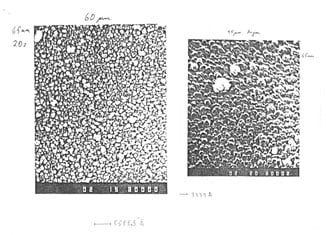
This observation was encouraging as it seemed to be some sort of confirmation the idea might be valid and that C60 might be forming. Here I made a fundamental mistake – and not for the first time! I assumed that C60 would only be formed in minuscule amounts and only detectable, if at all, by the most sensitive analytical technique available i.e. mass spectrometry. After all, how could C60 be easily made when it had avoided detection until nearly the end of the 20th century, and then only fleetingly, when its two more famous siblings, diamond and graphite, had been known since time immemorial. It is now hard, more than twenty five years later, when C60 is in every school science textbooks to realize that C60 was, prior to 1990, considered by some to be highly suspicious character and indeed by some (see above) even an imposter. Indeed some still claim to this day that we had no right to make the claims contained in the Nature paper (see “Candid Science” by Istvan Hargittai).
A Funding Problem
During this period together with my Sussex colleague Geoff Cloke, an expert in metal vapour deposition, I tried to obtain funds for an in-situ quadrupole mass spectrometer to monitor the electric discharge process directly and see if C60 could be detected. Having already obtained significant support from EPSRC to build a Rice-type cluster beam system with another Sussex colleague Tony Stace, I had to go elsewhere for the £12k I needed for the mass spectrometer. (NB: I had by the way tried to get Rick to buy one to monitor alternative possible C60 creation experiments that Jim Heath and I had been probing – but to no avail). In the event this modest proposal was turned down by Shell, BP and also the Royal Society. All indicated it was an interesting proposal but none was prepared to cough up £12k.
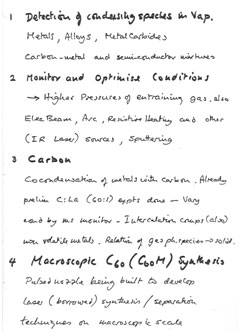
The Royal Society committee was so impressed it suggested we apply to EPSRC! We did have some funding from “British Gas” that a former student Steve Wood had managed to obtain for us to probe the idea I had that C60 must be a key constituent in a sooting flame. It is interesting to point out in this context that Mitsubishi now makes C60 in bulk quantities commercially by combustion of methane! Our small group had a lot of work on its hands! Unfortunately we did not get the quadruple MS which had unfortunate consequences for us at Sussex.
Krätschmer et al Enter the Scene
Then at some point a photocopy of a conference presentation abstract was sent to me by the astrophysicist Michael Jura a friend and colleague at UCLA. Michael had been to a conference in Capri where Wolfgang Krätschmer had presented a paper in which he and his colleagues presented intriguing evidence that they had detected four vibrational infrared bands of C60. At the top of the copy Mike had written, in his inimitable scrawl, “Harry, do you believe this?”.
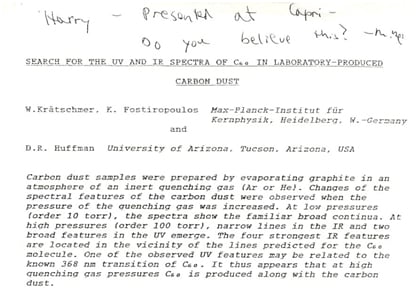
I must admit I found it very hard to believe. If Krätschmer and colleagues were correct I had “screwed up big time”. Instead of the minute amounts, needing the mass spectrometric sensitivity, that I had assumed were being formed in our evaporator, we must have already been making samples in which ca 1% of the deposit was C60; enough to detect by infrared spectroscopy! At just this moment, as luck would have it, Jonathan Hare was working for a DPhil with me. He had come to work on astrophysically related experimental problems. We immediately wheeled out the old modified evapourator and Jon started to make carbon films in an attempt to repeat the Krätschmer-Huffman experiments. On 22nd November 1989 we saw the first IR spectrum of C60 in his films at Sussex. Unfortunately then Jon had to spend time rebuilding the ancient apparatus. By the 5th March with UG project student Amit Sarkar he had worked out how to reproduce the IR spectrum reliably and we realized we must have some C60 in our hands!
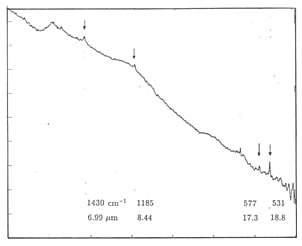
Then Jon wrote to Krätschmer to tell him that we had reproduced his results. I felt we were honour-bound that Wolfgang should be made aware that we were working on the problem. Although we had gone back to it because of their results it did not seem unethical as I had already been exploring this avenue and had been thwarted by being turned down for funding as indicated above and furthermore they had published their preliminary observations.
Fleeting Sightings of C60, the Orson Welles Character of the Third Form of Carbon Story
The dream I had always had was to prove our C60 conjecture by detecting the single 13C line NMR spectrum that C60 should exhibit as all sixty carbon atoms are equivalent. I had a quite a consistent track record in one-line assignments: In the 1970’s we had identified CH2=PH on the basis of one microwave line, then also HC5N, HC7N and HC9N all on the basis of single radio lines and of course C60 on the basis of one mass spectrometric line. I understand that these breakthroughs had led to my being called “One-Line Kroto” by the Monash microwave group! I took it as a complement, but I am not sure that that was the way it was meant! In July 1990 Jon gave a sample to Alla’a Abdul-Sada to check the mass spectrum and he obtained a 720 mass signal so we knew that we were on the right track. In discussion with Jon my thought was that as C60 looked like benzene from 20 angles (with its 20 hexagons) maybe it would be soluble in this solvent – not thinking of course that maybe the benzene line might overlap the C60 signal!
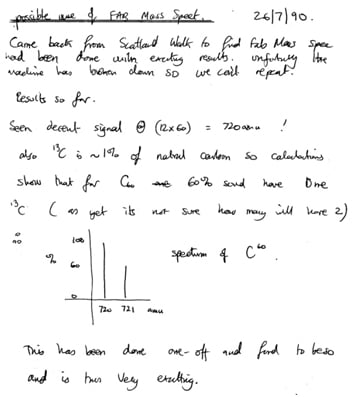
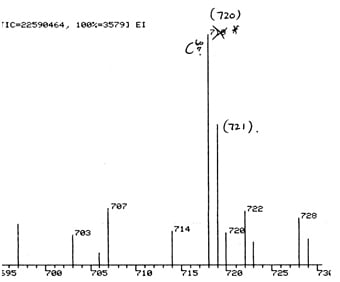
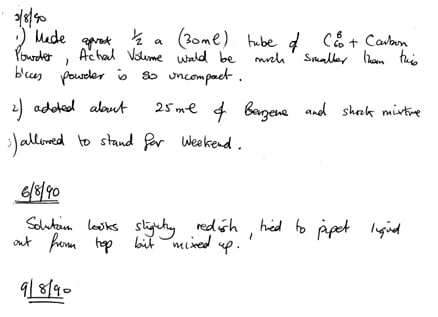
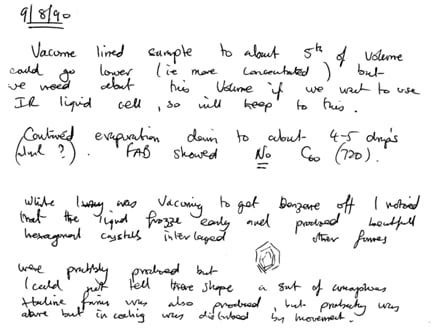
In the event one Monday morning (6th August 1990) Jon placed a small phial containing benzene in which his soot sample had been washed. It was a deep burgundy red.
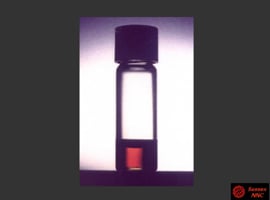
I was apprehensive and wondered whether a suspension of essentially invisible tiny microscopic particles might scatter and give the appearance of a red solution. On the following Thursday (9th) we tried to obtain a mass spectrum of the extract but our sampling procedure needed to be refined.
Black (and Red!) Friday
The next day – Friday August 10th, (Black Friday) I had a call from Nature – that’s the journal – Philip Ball asked me if I would referee a paper by Wolfgang Krätschmer and colleagues on C60. Without really thinking I said of course I would as I felt I was as expert as anybody else on this issue. One never realizes that a hurricane is coming: A fax arrived at 12.10 and as I read the title “Fullerite, a New Form of Carbon” my heart sank, then as I read further down the abstract – it got worse – I saw the words a “wine red solution” glaring at me from the fax and there in front of me on my desk was the Jon’s phial with the wine-red solution staring me in the face. They also had a fantastic photograph of C60 crystals together with some all-important X-ray data that showed that they had obtained crystals consisting 1nm diameter spheroidal molecules – it was all totally convincing. I knew instinctively that it was correct.
I wondered whether to commit suicide or go for lunch. What the hell – as any student knows – there is not a lot of difference between lunch in a university canteen and suicide – so I went for lunch. After lunch on returning to my office I called Philip at Nature to tell him that this was proof positive that they definitely had C60 and asked him to call Krätschmer and say I waived anonymity and congratulate him and his colleagues. Philip asked who else did I recommend as a referee and I suggested that Bob Curl, the Rice Group’s consilieri, would be the best. I consider this paper one of classic chemistry papers of the 20th century in that they had conjectured they might have C60 from earlier electronic spectroscopy studies of carbon particles and then had used the four infrared vibrational modes that Group Theory indicated would be fingerprint bands as the key step in tracking it down. I think their study should be used in all chemistry courses as an iconic example of the way Group Theory can be a powerful tool in science – indeed I doubt there has ever been a more important or perfect example. One might think that the Group Theoretical derivation would be difficult but it turns out to be fairly straight-forward as almost all terms cancel out.
The Single NMR Line
Anyway, what to do now – if anything? We had been so close and I felt that we had really been thwarted by the funding system. It would have certainly been unfair to Krätschmer and colleagues had we won this race but I felt it had certainly been unfair to us too in the circumstances of not getting the support I needed to probe the electric arc avenue. However, as I carefully re-read the paper I thought about the fact that there was no mass spectrum in the manuscript and we had a 720 signal and in particular there was no NMR line – my dream-line! I subsequently learned that Krätschmer et al did have the crucial mass spectrometric data but there had been some understandable problems associated with presenting it. My friend and former Sussex colleague Ken Seddon had encouraged me long before to just go all out for the nmr line – if only I had heeded his advice! In the event after all the trials and tribulations, especially failing to get the financial support I needed for essentially the same experiment as Krätschmer et al., I felt that we were justified in continuing. I decided we must drive on to obtain my coveted NMR line – after all coming in second to Krätschmer et al’s brilliant work was not that bad especially as Jon had made the most important breakthrough ever made in my laboratory by extracting C60, one week prior to the arrival of that fateful fax from Nature.
One Line to Prove it All beyond Reasonable Doubt
Jon gave all of his precious sample to my Sussex colleague Roger Taylor who, with the help of Jim Hanson, developed the chromatographic technique that is now the standard procedure for separating members of the fullerene family. Roger found that Jon’s red solution contained at least two molecules; C60 and C70. The sample was red because of C70, though present at significantly lower concentration, had a stronger spectrum and its colour masked the stunningly beautiful delicate magenta of C60.
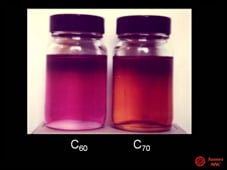
The precious single line nmr spectrum of C60 and the confirmatory five lines of C70 were detected by Tony Avent – who should have been a co-author of the resulting paper.
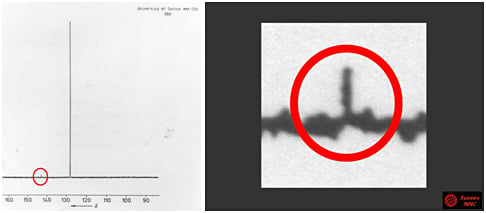
In our preliminary manuscript one of C70‘s five lines had not been identified correctly as it lay very close to the benzene line; this was however corrected in the final manuscript that was published.
The Third Key Paper in the Buckyball Saga
As “luck” would have it at just this moment I happened to be travelling to a conference in Freiburg and then was to go on to another conference on Brioni. With the preliminary manuscript in my hand, I felt I must stop off in Heidelberg to see Wolfgang Krätschmer and show him the manuscript as I wanted to make sure that he was comfortable with the wording in our manuscript. After all the trials and tribulations I of course wanted to claim as much credit as possible for our Sussex team without taking anything away from the Krätschmer-Huffman work: In particular we had obtained a 720 mass signal and solvent extracted C60 independently prior to the arrival of the heartbreaking fax. Furthermore we had chromatographically separated C60 and C70 and confirmed both the structures by NMR. Wolfgang was most gracious and said he was happy with the manuscript. In the event our preliminary unpublished manuscript, which gave full details of how to separate C60 and C70, as well as nmr data on C60 and our preliminary data on C70 propagated like wildfire. It found its way into the hands of others such as Robert Whetton and Francois Diederich, both of whom had in earlier times been critical of our Buckminsterfullerene structure proposal. They followed our recipe and, not surprisingly, confirmed our results.
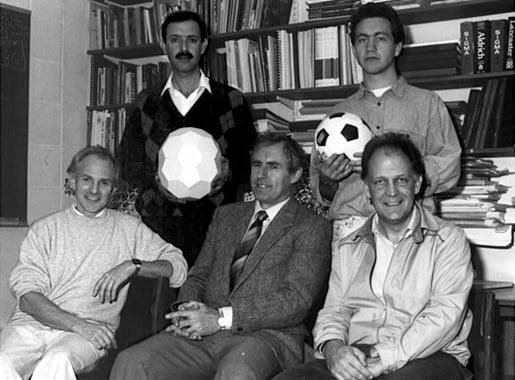
The Aftermath … 1990 onwards
After the Krätschmer-Huffman breakthrough I decided to delay my aim of doing graphics more seriously and spend about five years researching the implications of the discovery. With Roger Taylor and David Walton I set up an intensive research initiative, the Sussex Nanoscience and Nanotechnology Centre, and proceeded to explore the chemistry and chemical physics of the Fullerenes. Of course as is well known Sumio Iijima explored the material produced in the K-H soot generator and found nanotubes were being created. These structures had been observed by Morinobu Endo and coworkers several years previously in 1976 but here suddenly was a way to make them in sufficient quantities to study them in detail. The Fullerene breakthrough had not only opened up a whole new area of chemistry, presently averaging ca 1000 papers per year, but a vast new area of nanoscience and nanotechnology as the nanotubes turned out to have fascinating electrical and mechanical properties promising new materials with exceptional strength and outstanding electromagnetic behaviour. At Sussex we played quite an important part as our group succeeded in making important contributions to the use of C60 and C70 as synthons. We also explored the ramifications of the nanotube breakthrough and made contributions to our understanding of how they were formed, especially in the presence of a catalyst and in condensed phase.
At the beginning of 1996 much to my total amazement I was offered a knighthood which I duly accepted and later that year in October it was announced that Bob Curl, Rick Smalley and I were to be awarded the Nobel Prize. From then onwards many things changed. I had always been heavily involved in educational initiatives but now the knighthood and the prize made it a bit easier to get the funding needed to explore the way new educational technologies involving the Internet might improve the general understanding of science. It also gave me an opportunity to represent the views of many in the scientific community more widely. I set up the Vega Science Trust which created science programmes – at first for TV and then to stream on the internet at www.vega.org.uk. Numerous great programmes can be found there including numerous interviews with Nobel Laureates.
In 2004 I retired from my position at the University of Sussex and took up a position at Florida State University. This was something that I had never thought about but of course one seldom makes relatively momentous decisions such as emigrating to another country unless one has to. In this case FSU was not only keen for me to continue research but also to explore new ways of using the Internet for educational outreach. This led to the creation of the GEOSET project (www.geoset.info and www.geoset.fsu.edu) which aims to create a globally distributed cache of educational material accessible free worldwide and created by the best teachers on the planet. As this project started, a wonderful bonus surfaced; this was the fact that our students are a great source of imaginative educational material. Not only that, their presentations have become part of their resumés and in particular the use of the URLs of their presentations, when inserted into references and applications, ensure that their individual abilities in presentation and what they find interesting and how they think become much more transparent than is possible when reading through a pile of arid paperwork. I suspect that these sorts of presentations will soon become “de rigeur” requirements – even just to make the shortlist for jobs, fellowships, awards and scholarships.
Ever since I had carried out radioastronomy research in the mid 1970s and had started to give relatively popular general lectures on astrophysical chemistry I had found that I had received quite a lot of invitations to lecture around the world. The conflation of astronomy with chemistry turns out to be an excellent recipe for teaching chemical physics in particular my research speciality spectroscopy. After the prize in 1996 the number of invitations multiplied until now they arrive at a rate of almost one a day. Particularly important are the Lindau Nobel Symposia where I always go when invited as I feel that many of the young people there will in the future attain positions of significant social responsibility and I always aim in some part of my presentations to make the audience think!
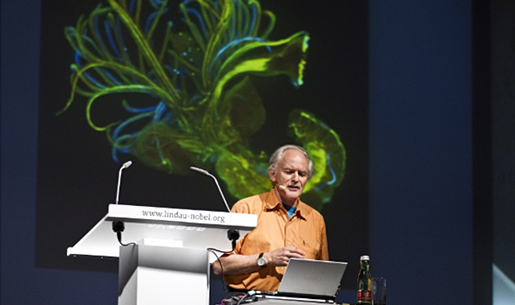
In general we try to accommodate as many student events as possible as I think it is important that young people realize that Nobel Laureates are no different from other people and in general no smarter and Lindau is one of the best places for this.
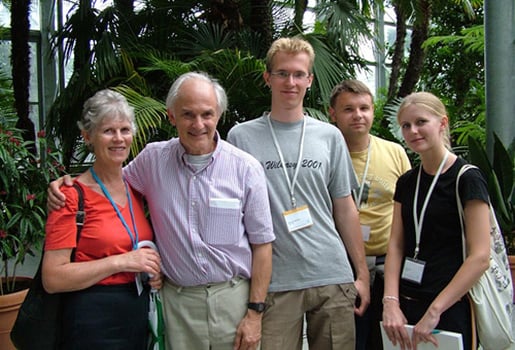
The response of young people in India, China, Japan and Korea when a Nobel Laureate is to give a lecture is often phenomenal and certainly should be a lesson to the West. At one venue in China the students stood 5 abreast all the way down the aisles of the lecture theatre during the whole presentation and some told me they had arrived at 7 am to get a seat for my lecture at 10 am! I also present Buckyball Workshops for very young children. Earlier ones were carried at British Association meetings in the UK with Jon Hare but many have been held all over the world: Florida, Texas, California, Sweden, Malaysia, India, Japan, China and even by Internet to Iceland and to 2000 kids across the whole of Australia.
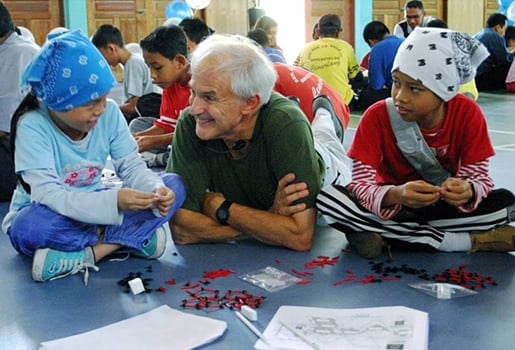
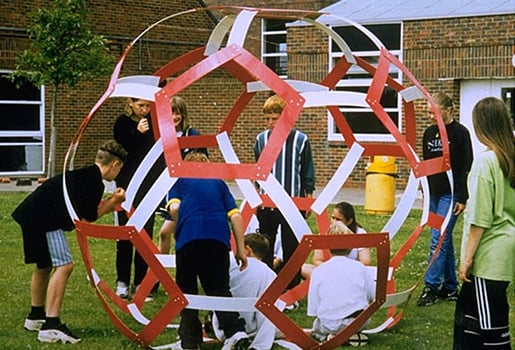
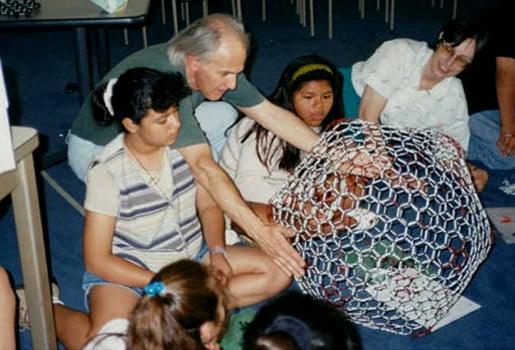
I decided to do as many lectures as possible especially for schools as I gradually have felt it necessary to communicate with a significant group of young people who, on arriving at our Universities – which I consider oases of intelligence in a sea of ignorance – develop an astute analytical approach to all aspects of life. Richard Feynman in his small and interesting book “The Meaning of it All” discusses this group of students. When I first read this chapter I did not think it was as large a number as Feynman suggested, but latterly I have found it to be very large. Especially in my general science lectures I highlight the fact that Natural Philosophy (the basic cultural concept that subsumes science) “is the only philosophical construct we have devised to determine truth with any degree of reliability”. I point out that the ethical purpose of education must be the schooling of young people in the ways of deciding what they are being told or what they believe is actually true. Without knowledge-based on evidence, anything goes. Indeed almost anything does go and as Bertrand Russell says “man is a credulous creature and without good reason to believe he is satisfied with bad” In fact I would suggest man is highly susceptible to being convinced that comforting mystical concepts, for which there is no adequate foundation, are true – even though a moment’s rational deliberation indicates that they must be palpably false. As President Kennedy once said: “The great enemy of the truth is very often not the lie, deliberate, contrived and dishonest, but the myth, persistent, persuasive, and unrealistic. Belief in myths allows the comfort of opinion without the discomfort of thought.”
The complexity of living 9 months in the US and the 3 summer months based in the UK together with the feeling that I should speak to this constituency of young people has made life so complicated that my wife Margaret has shouldered the arduous burden of managing the logistical issues as well as the day-to-day problems of survival. Hardly a week goes past when we do not have to travel to a venue somewhere in the world. For several years now I have averaged some 70-80 lectures per year away from our home town and often in another country. I try to go to as many student events as possible because I feel able to give a measure of support to many students disconcerted by the way that analytical thought undermines the unsubstantiated, and unsubstantiatable, mystical dogmas that many have been brought up to accept before they have developed the analytical skills to ask questions about their veracity. As Abelard said “By doubting we come to enquire and by enquiry we arrive at truth”. There is almost no widespread infrastructure available for freethinking young person commensurate with the plethora of churches, mosques synagogues, temples and shrines populated by the purveyors of mystical dogma. When disconcerting questions arise as they do quite naturally in the doubting mind it may cause complex problems both at an intellectual level for sensitive students and also on a day-to-day personal level especially within families for whom mystical issues may be very important.
I still find a bit of time to do what I feel most comfortable and able to do which is art and graphics – not as much as I would like and I really only have time to do the odd poster and logo when commissioned such as these recent ones for the Alliance Française Tallahassee, the Kroto Research Institute in Sheffield and an Internet Buckyball Workshop for 2000 small children across the whole Continent of Australia – earlier ones are at www.kroto.info.

In response to a request by Fuzambo, a Japanese publisher, we have produced a children’s science book in Japanese entitled “Benjy and Bruno in Nanoland” (English translation), cover Fig 15 (translated into Japanese by Toru Maekawa).
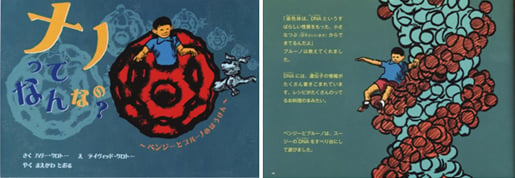
Our younger son David created the characters of the little boy Benjy and his dog Bruno, my wife Margaret and our older son Stephen refined the storyline and I pulled the graphics together for publishing. The little boy and his dog become smaller by a factor of ten every time they encounter an object or animal that has a geodesic polyhedral structure in which pentagonal and hexagonal domains are involved such as in the case of a soccer ball, the eyes of a fly, viruses etc. They finally become so small that they end up swimming along the veins of one of Benji’s friends. It is a book which attempts to give small children an idea of the scale in a similar way to various “Powers of Ten” efforts. It is to appear in English in due course.
At FSU where I have been since 2004-2005 I have been able to carry out interesting research in metal organic framework (MOF) materials and cluster science. I have also been able to plant GEOSET seeds in several institutions around the world. The gateway site is at www.geoset.info. Fortunately my new colleagues at FSU, in particular Naresh Dalal and Alan Marshall, have been great co-workers and Tony Cheetham now at Cambridge has also helped me in the daunting task of starting research off again. It is pretty difficult getting a research programme up-and-running the first time when one is young, but doing it a second time from scratch when you have the knowledge of how difficult it was the first time, makes it seem twice as hard.
Sir Harold Kroto died on 30 April 2016.
Copyright © The Nobel Foundation 2012Nobel Prizes and laureates
Six prizes were awarded for achievements that have conferred the greatest benefit to humankind. The 14 laureates' work and discoveries range from quantum tunnelling to promoting democratic rights.
See them all presented here.
